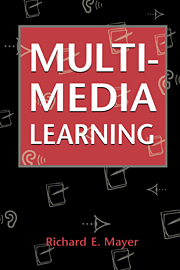Book contents
- Frontmatter
- Contents
- PREFACE
- 1 The Promise of Multimedia Learning
- 2 Multimedia Instructional Messages
- 3 A Cognitive Theory of Multimedia Learning
- 4 Multimedia Principle
- 5 Spatial Contiguity Principle
- 6 Temporal Contiguity Principle
- 7 Coherence Principle
- 8 Modality Principle
- 9 Redundancy Principle
- 10 Individual Differences Principle
- 11 Principles of Multimedia Design
- REFERENCES
- AUTHOR INDEX
- SUBJECT INDEX
1 - The Promise of Multimedia Learning
- Frontmatter
- Contents
- PREFACE
- 1 The Promise of Multimedia Learning
- 2 Multimedia Instructional Messages
- 3 A Cognitive Theory of Multimedia Learning
- 4 Multimedia Principle
- 5 Spatial Contiguity Principle
- 6 Temporal Contiguity Principle
- 7 Coherence Principle
- 8 Modality Principle
- 9 Redundancy Principle
- 10 Individual Differences Principle
- 11 Principles of Multimedia Design
- REFERENCES
- AUTHOR INDEX
- SUBJECT INDEX
Summary
Multimedia (as used in this book) refers to the presentation of material using both words and pictures. The case for multimedia rests in the premise that learners can better understand an explanation when it is presented in words and pictures than when it is presented in words alone. Multimedia messages can be described in terms of the delivery media (e.g., amplified speaker and computer screen), presentation mode (e.g., words and pictures), or sensory modalities (e.g., auditory and visual). The process of multimedia learning can be viewed as information acquisition (in which multimedia messages are information delivery vehicles) or as knowledge construction (in which multimedia messages are aids to sense making). Three possible learning outcomes are no learning (as indicated by poor retention and poor transfer performance), rote learning (as indicated by good retention and poor retention performance), and meaningful learning (as indicated by good retention and transfer performance). Meaningful learning outcomes depend on the cognitive activity of the learner during learning rather than on the learner's behavioral activity during learning.
WHAT IS MULTIMEDIA?
The term multimedia means different things to different people. For some people, multimedia means that a person sits at a computer terminal and receives a presentation consisting of on-screen text, on-screen graphics or animation, and sounds coming from the computer's speakers – as with an on-line multimedia encyclopedia. For some people, multimedia means a “live” presentation in which a group of people seated in a room views images presented on one or more screens and hears music or other sounds presented via speakers.
Information
- Type
- Chapter
- Information
- Multimedia Learning , pp. 1 - 20Publisher: Cambridge University PressPrint publication year: 2001
Accessibility standard: Unknown
- 1
- Cited by
